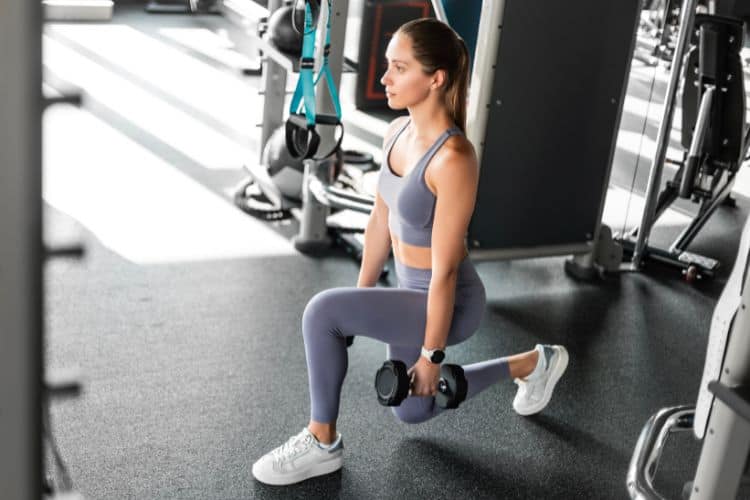Sign up for workout ideas, training advice, reviews of the latest gear and more.






Build Muscle, Burn Fat, and Maximize Strength with One Pair of Dumbbells When it comes to effective, time-efficient workouts, nothing beats a 45-minute full-body dumbbell strength training routine. Whether you’re training at home or in the gym, dumbbells are versatile tools that help you build muscle, boost endurance, and increase functional strength without bulky machines or fancy equipment.
In this blog post, we’ll break down an optimized, science-backed 45-minute dumbbell workout that targets every major muscle group using compound and isolation movements. You’ll also find warm-up recommendations, rest intervals, form tips, and progression strategies to make every session count.
A full-body dumbbell workout trains multiple muscle groups in one session, which increases muscle activation and elevates your heart rate, helping you burn fat while gaining strength. Compared to split routines, full-body training sessions are incredibly time-efficient, especially when paired with compound movements.
Dumbbell exercises closely mimic natural movement patterns, making them ideal for functional strength training. They improve balance, coordination, and joint stability — all critical for daily activities and injury prevention.
Combining multi-joint dumbbell movements with controlled rest periods creates an intense session that spikes excess post-exercise oxygen consumption (EPOC), commonly known as the afterburn effect. That means your body continues to burn calories even after the workout is over.
| Phase | Time | Focus |
|---|---|---|
| Warm-Up | 5 mins | Activate and mobilize joints |
| Workout (3 Circuits) | 35 mins | Total-body dumbbell strength |
| Cool-Down & Stretch | 5 mins | Recovery and flexibility |
Each circuit consists of 4 compound or isolation exercises, with 3 rounds per circuit. Rest 30 seconds between exercises and 60 seconds between rounds.
Before diving into lifting, take five minutes to warm up and prep your muscles for movement.
This warm-up increases blood flow and lubricates joints, reducing your risk of injury during your strength session.
Muscles Worked: Chest, shoulders, triceps
Muscles Worked: Lats, rhomboids, rear delts, biceps
Muscles Worked: Deltoids, triceps
Muscles Worked: Biceps, shoulders
Complete 3 rounds. Rest 60 seconds between rounds.
Muscles Worked: Quads, glutes, hamstrings, core
Muscles Worked: Hamstrings, glutes, lower back
Muscles Worked: Quads, glutes, calves
Muscles Worked: Calves
Complete 3 rounds. Rest 60 seconds between rounds.
Muscles Worked: Obliques, abdominals
Muscles Worked: Core, back, arms
Muscles Worked: Total body
Muscles Worked: Core, hip flexors
Complete 3 rounds. Rest 60 seconds between rounds.
End your session with light stretches to improve flexibility and accelerate recovery.
To keep building strength, increase the challenge over time. Add more weight, reps, or sets every 1–2 weeks.
Always prioritize proper form over rushing through reps. This prevents injury and ensures targeted muscle activation.
Logging your reps, weights, and rest times helps you stay consistent and track progress toward your goals.
To prevent plateaus, occasionally switch up dumbbell variations, such as replacing reverse lunges with Bulgarian split squats.
This workout maximizes your time by targeting every major muscle group in just 45 minutes. Compound movements like squats, deadlifts, and presses stimulate multiple muscles at once.
Thanks to minimal rest between sets and total-body activation, you’ll experience elevated heart rates, giving your cardiovascular system a boost alongside muscular development.
Strength training increases lean muscle mass, which in turn boosts resting metabolic rate (RMR). This means you’ll burn more calories throughout the day, even when you’re resting.
You don’t need an entire gym to get results. With just a pair of dumbbells, you can complete this routine from anywhere — living room, backyard, or local fitness studio.
Eat a balanced meal 1–2 hours before training. Aim for complex carbs and lean protein (e.g., oatmeal and eggs or banana with Greek yogurt).
Refuel with protein and carbs to support muscle recovery. Good options include a protein shake with fruit, grilled chicken with sweet potato, or cottage cheese with berries.
Stay hydrated before, during, and after your workout. Water supports muscle function and reduces fatigue.
| Day | Workout |
|---|---|
| Monday | 45-Min Full Body Dumbbell Strength |
| Tuesday | Rest or light cardio (walking, cycling) |
| Wednesday | 45-Min Full Body Dumbbell Strength |
| Thursday | Yoga or active recovery |
| Friday | 45-Min Full Body Dumbbell Strength |
| Saturday | HIIT or circuit workout |
| Sunday | Rest |
The 45-minute full body dumbbell strength training workout is perfect for busy individuals who want results without spending hours at the gym. With consistency, progressive overload, and proper nutrition, you’ll increase your strength, build lean muscle, and burn fat all at once.
Whether you’re working out at home or at the gym, dumbbells provide the ultimate balance of simplicity and power. Start incorporating this workout into your weekly schedule, and you’ll be amazed at how much progress you can make in just a few weeks.
Want more workout and video guide?
Follow us on Pinterest, Facebook, and Subscribe to our Newsletter and Stay tuned for FREE downloads of our App coming soon!
Stay up to date on the latest women’s health, fitness and lifestyle trends and tips.